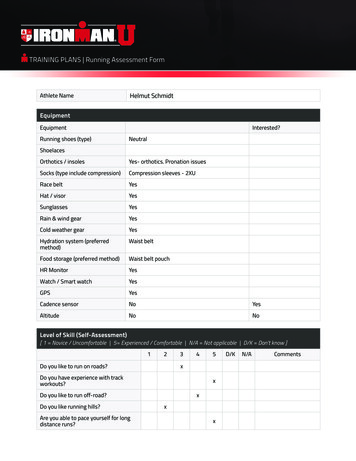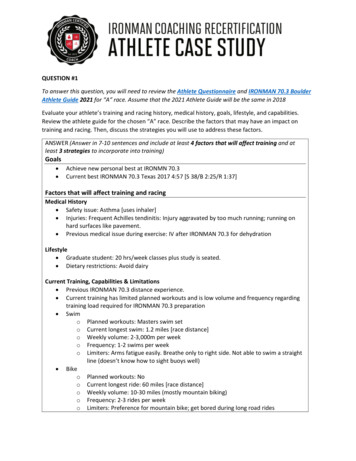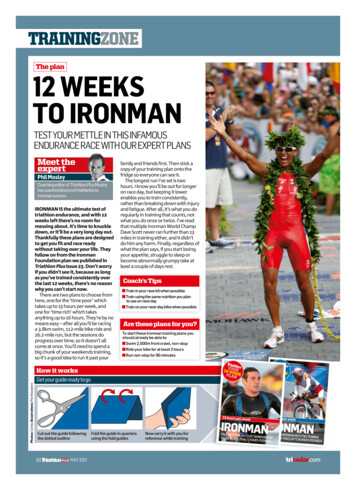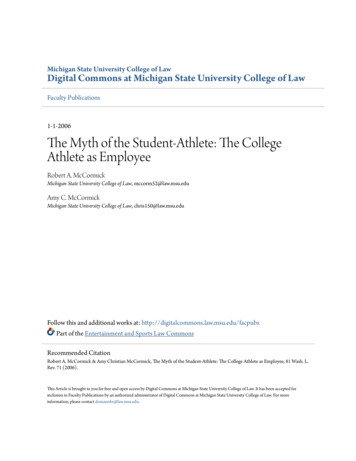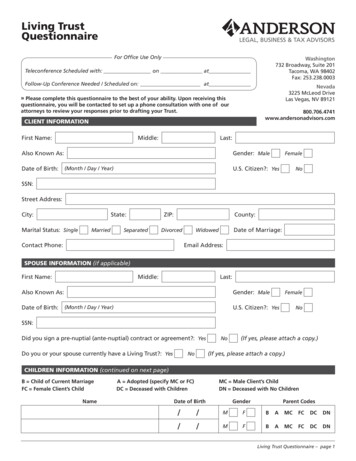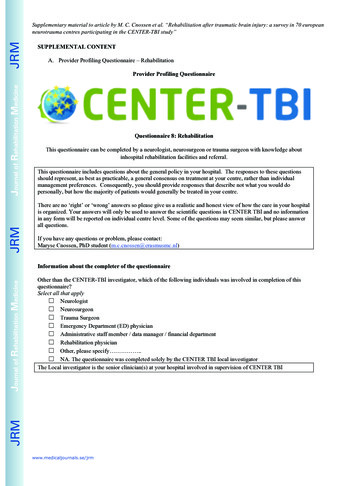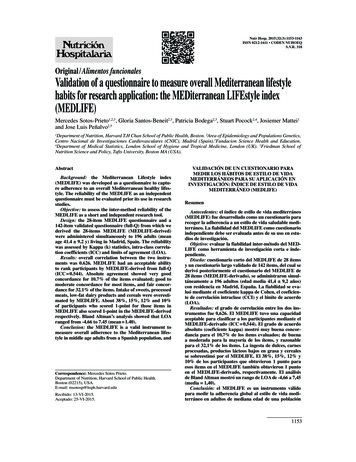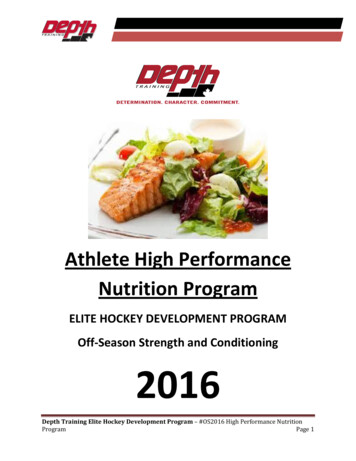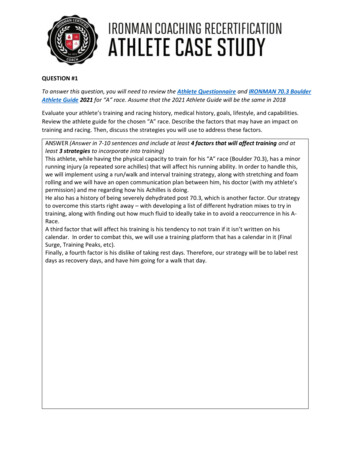
Transcription
QUESTION #1To answer this question, you will need to review the Athlete Questionnaire and IRONMAN 70.3 BoulderAthlete Guide 2021 for “A” race. Assume that the 2021 Athlete Guide will be the same in 2018Evaluate your athlete’s training and racing history, medical history, goals, lifestyle, and capabilities.Review the athlete guide for the chosen “A” race. Describe the factors that may have an impact ontraining and racing. Then, discuss the strategies you will use to address these factors.ANSWER (Answer in 7-10 sentences and include at least 4 factors that will affect training and atleast 3 strategies to incorporate into training)This athlete, while having the physical capacity to train for his “A” race (Boulder 70.3), has a minorrunning injury (a repeated sore achilles) that will affect his running ability. In order to handle this,we will implement using a run/walk and interval training strategy, along with stretching and foamrolling and we will have an open communication plan between him, his doctor (with my athlete’spermission) and me regarding how his Achilles is doing.He also has a history of being severely dehydrated post 70.3, which is another factor. Our strategyto overcome this starts right away – with developing a list of different hydration mixes to try intraining, along with finding out how much fluid to ideally take in to avoid a reoccurrence in his ARace.A third factor that will affect his training is his tendency to not train if it isn’t written on hiscalendar. In order to combat this, we will use a training platform that has a calendar in it (FinalSurge, Training Peaks, etc).Finally, a fourth factor is his dislike of taking rest days. Therefore, our strategy will be to label restdays as recovery days, and have him going for a walk that day.
QUESTION #2Create a weekly training schedule for the first two (2) microcycles in the Pre-Competition subphase forthe athlete’s training plan for the athlete’s “A” race.Use the sample Novice IRONMAN 70.3 20 Week Training Plan, Athlete Questionnaire and the 2017IRONMAN 70.3 Boulder Athlete Guide as a guide for the following information required in the schedule:1. Identify the average training intensity zone and goals for the microcycle2. Create a schedule of training sessions3. For each training session enter the discipline (swim, bike, run, strength), the duration and theintensity of the session (by zones) Note: S Swim ; B Bike; R Run; St Strength4. For each discipline, identify the key high intensity session with an H; Identify the key endurancesession with an E5. Identify the strength and conditioning phase as either stability/endurance (S&E); strength (MS);Power (P); Maintenance (M)Microcycle #1Phase: Pre-CompetitionMicrocycle Average Training Intensity: 3 to 4Microcycle Goals: Holding Longer Time daySundaySession1S: E(1:00:00)B:H(45:00)S:H(1:00:00)R: H(50:00w/Longw/u)B: EOFFB:E(2:50:00)Session2St: S&E(30:00)R: E (1:30 St: (1:00:00)S: H(45:00)StretchStretchStretch
Microcycle #2Phase: Pre-CompetitionMicrocycle Average Training Intensity: Primarily 4 with some speed workoutsMicrocycle Goals: Getting comfortable at higher speeds for longer times with some higher ridaySaturdaySundaySession1S: EB: ES:HR: EB:HOFFB: t: S&ER:HSt: MSS: er the total number of hours and session for each weekWeek 1# HoursWeek 2# Sessions# Hours# SessionsSwim 2:4532:503Bike 4:3534:503Run 2:2022:252Strength 1:0021:0021011:0510Total 10:40Please state at least three changes you are making and reasons for the changes to the sample NoviceIRONMAN 70.3 20 Week Training Plan. (1-2 sentences each)1. I’ve focused on less running in place of biking for the endurance building. This is due to his past injury– and not enflaming that Achilles.
2. I’ve incorporated interval endurance in both the bike and the run – This allows him scheduled time fornutrition intake and rehydration.3. I’ve included strength training on 2 days instead of one to be sure he puts separate attention on bothstability and muscular strength.QUESTION #3Using the athlete’s Bike Assessment Form, write a 75 minute bike workout as a key high intensitysession for your athlete for the Pre-Competition subphase for their “A” race.Include warm up, main set and cool down with appropriate intensities for the training phase along withtwo drills. Address considerations from biking experience, lifestyle and any past injuries (1 sentenceeach). State any assumptions that you are making when writing the workout.Subphase:Pre-CompetitionDuration:75 minutesIntensity:3-4Goal:Increase Z3 Tempo pacing, with intermittent Z4work to simulate hills in BoulderWarm Up:10:00 building from RPE 3 to RPE 5, HR starting at 140 increasing to 147Main Set:Drill 1: 5x(0:30 80% right leg; 0:30 80% left leg)Rehydrate.Drill 2: 5x(2:00 Hold at RPE 8, HR at approx. 157 – 164; 1:00 Easy sitting recovery atRPE 3)Rehydrate.10:00 Steady ride at RPE 6, HR at approx. 148 – 156
Repeat entire Main set for a total of two (2) times.Cool DownConsiderations:5 minutes EASY cool down at RPE 3, HR at approx. 1401. Biking Experience: Based on his experience mainly mountain biking, he needsexperience holding a higher intensity (like Z3) for an extended period of time.2. Lifestyle: He does not like to allow people to pass him. This workout will requirehim to maintain a steady pace for 10 minutes regardless of people passing him.3. Past injuries: Last 70.3, he needed to go to the medical tent for dehydration. Inorder to help him gain practice with hydrating frequently, his workout has“rehydrate” as a step he needs to do.Assumptions:1. That he can hold Z3 for 10 minutes2. That he does not have any specific biking injuries3. That he has the time to do a 75 min workout
Why did you choose those drills? (1-2 sentences each)1. Drill #1: Although his bike assessment says both sides are equal, this drill will either affirm this, or hewill notice that one side is weaker and will begin working on that side.2. Drill #2: This drill will simulate climbing the hills in Boulder, where you need a steady strong intenitylevel.QUESTION #4:At your athlete’s last IRONMAN 70.3 race on an exceptionally hot and humid day, the athlete becameseverely dehydrated and had to be treated in the medical tent afterwards.When you asked him about what happened, he said that he only drank 1 bottle of sports drink (25 gcarbohydrates per bottle) during the bike because he forgot to drink and skipped most of the run aidstations. He said that he did remember to eat a gel (25 g carbohydrates per gel) every 30 minutes for thebike and run.What changes would you make to his current fueling and hydration plan and why? (2-3 sentences)In order to be sure the athlete properly fuels/hydrates, we would practice taking in his hydration atspecific intervals. I would suggest he have a goal of drinking 4 oz. of fluid every 15 minutes to start,working up to 8 oz. He then would have the goal of consuming 60 g. of carbs per hour as well and hewould do this all by having a timer that goes off every 15 minutes as a reminder to eat/drink.How can the athlete monitor his hydration status during and after training? (2-3 sentences)The athlete can monitor his hydration status by filling out a chart/keeping a record of his fluid intake andhow he felt. As his coach, I would then review and discuss with him the results.What strategies will you have your athlete practice to stay hydrated in the future? (2-3 sentences)In the future, I would have this athlete maintain a MINIMUM hydration intake (amt to be determined byathlete’s specific needs at that time) every training day, along with maintaining his water intake. Doingthis will create a plan to form a healthy habit going forward that will keep him out of the medical tentfor dehydration in the future.
QUESTION #1 To answer this question, you will need to review the Athlete Questionnaire and IRONMAN 70.3 Boulder Athlete Guide 2021 for "A" race. Assume that the 2021 Athlete Guide will be the same in 2018 Evaluate your athlete's training and racing history, medical history, goals, lifestyle, and capabilities.
